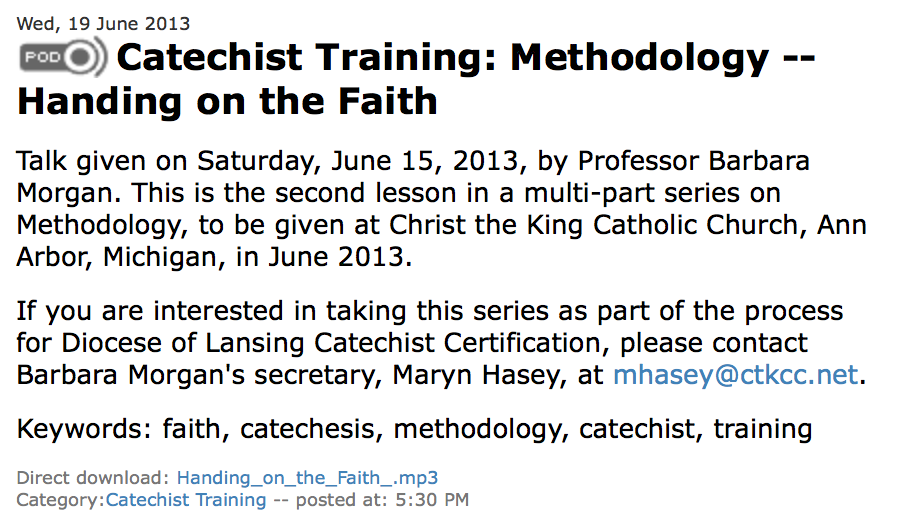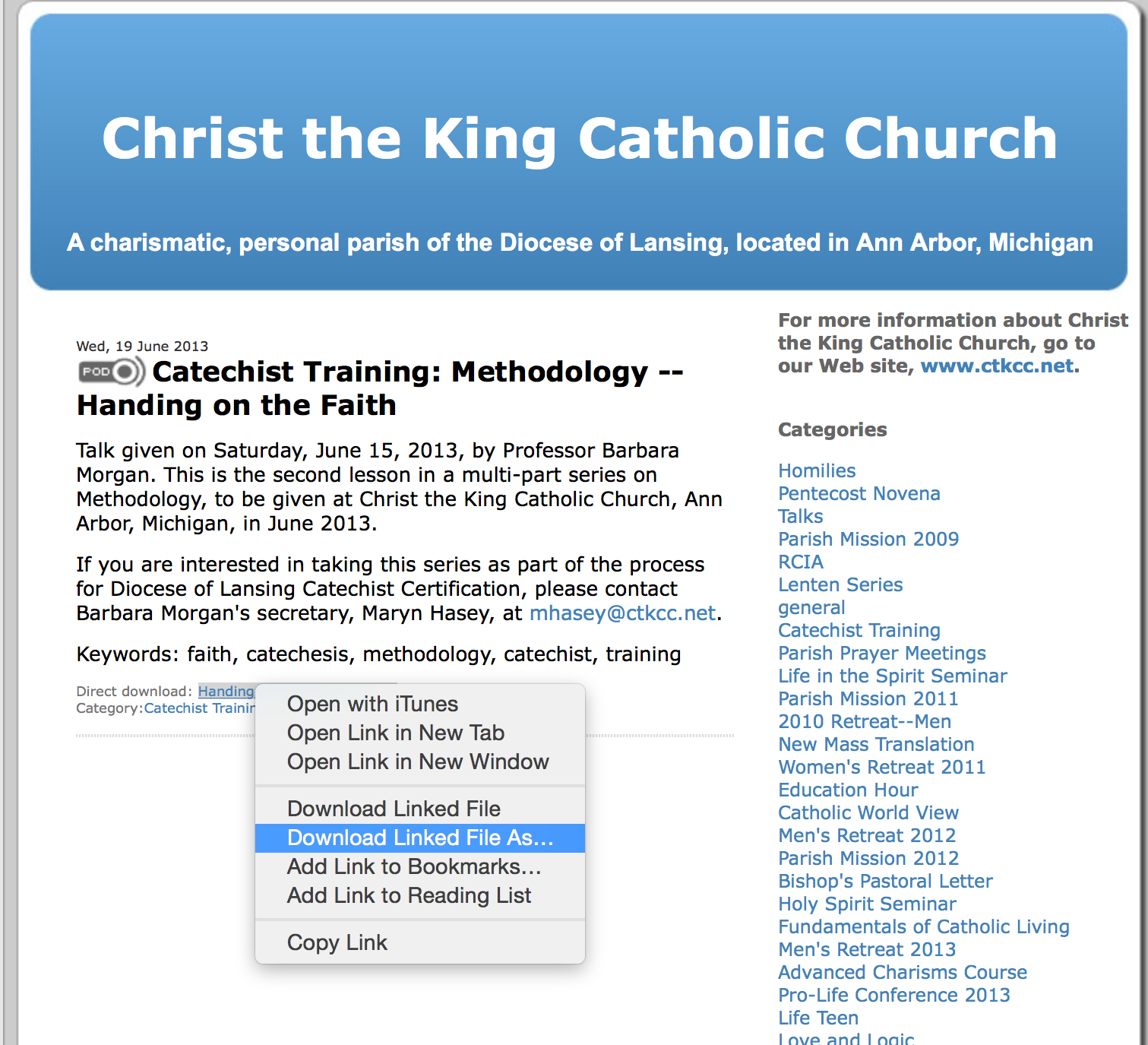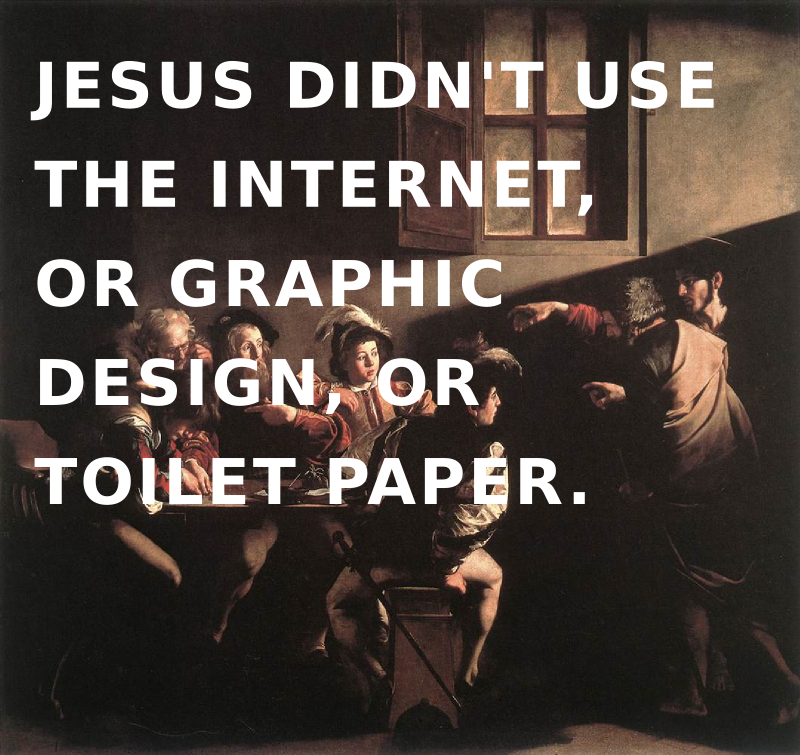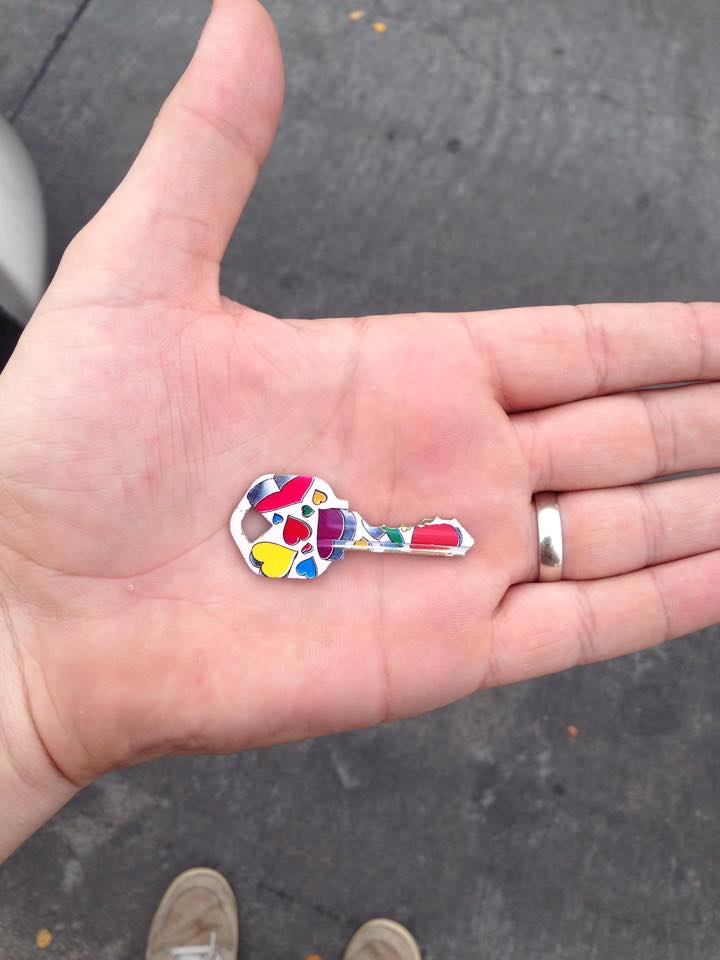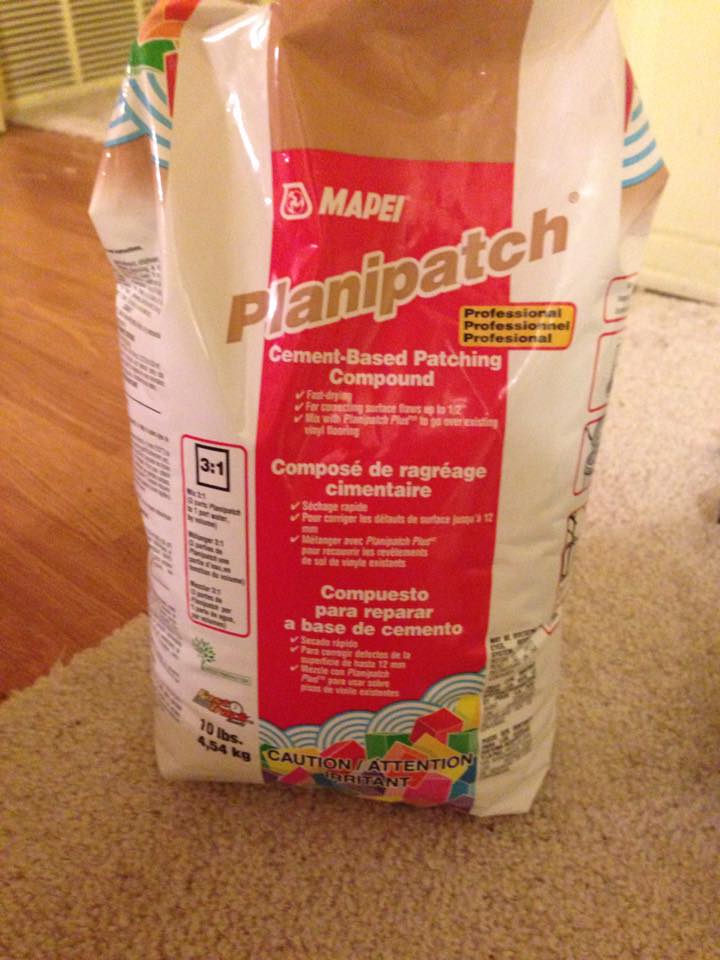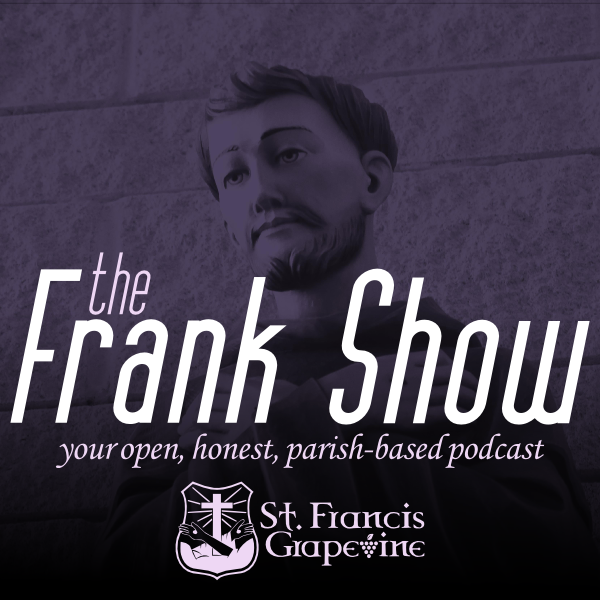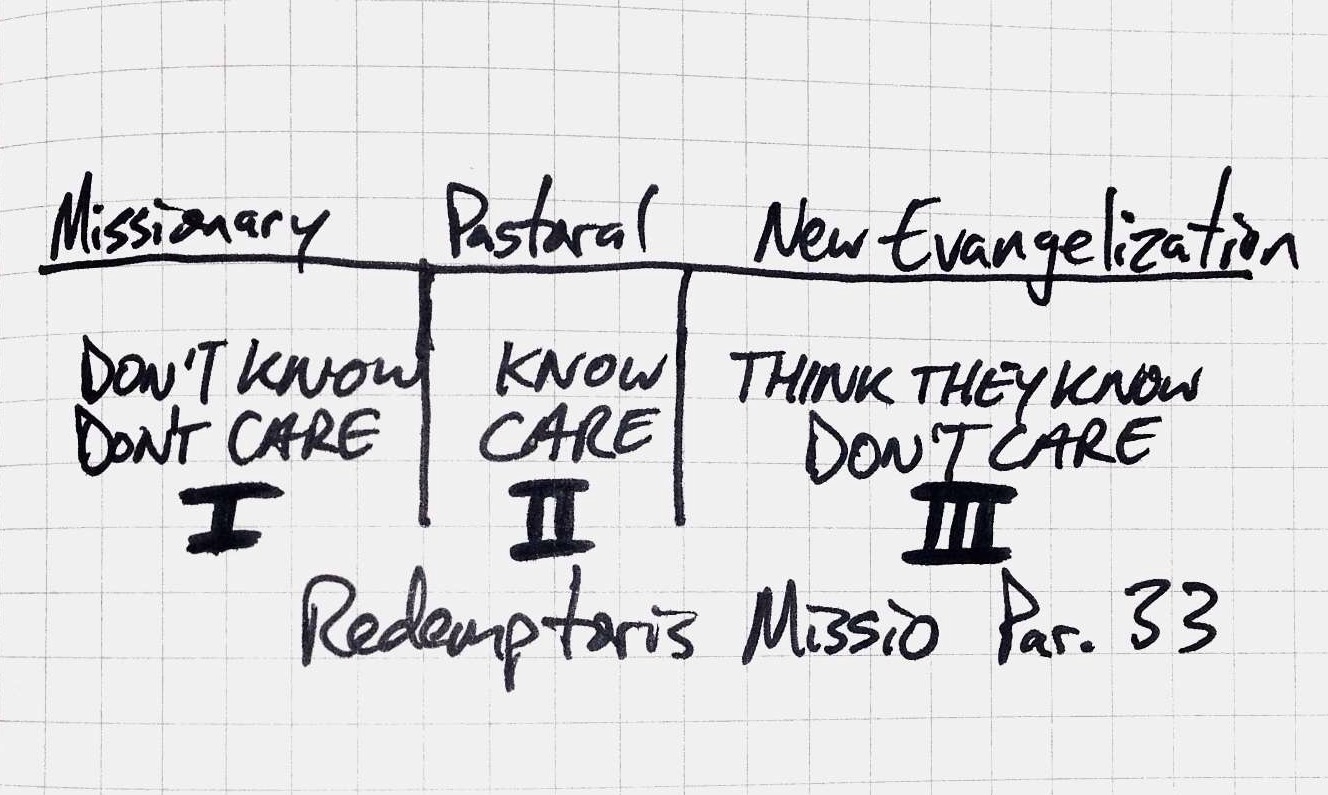Helping Catholic Parish Ministers unlock their ministry and defeat burnout forever. ❤️🔥
First Communion Parent Workshop
I gave a workshop today for parents of children receiving First Communion. It was part of a two hour workshop where the kids were taken out for catechesis on the Eucharist and the parents stayed for a brief session put on by me. We ended the workshop with a few minutes of adoration in the Church. [soundcloud url="https://api.soundcloud.com/tracks/189988038" params="color=1b595f&auto_play=false&hide_related=false&show_comments=true&show_user=true&show_reposts=false" width="100%" height="166" iframe="true" /]
I focused a great deal on initial evangelization and invitation to a personal relationship with Jesus and less on the actual content of the Eucharist and Confession (which I did cover for the last 25 minutes of the workshop after the prayer when the recording stops) because often sacramental preparation is an opportunity to reach out to people who may not have ever been invited to a relationship with Jesus or experienced a profound conversion experience that gives meaning to everything we do as Catholics.
This was my attempt at a proclamation of the kerygma centered on communion with Jesus in the Eucharist.
"He who eats my flesh and drinks my blood abides in me and I in Him." John 6:56
This talk was influenced a great deal by the book Forming Intentional Disciples
To say this talk was heavily influenced by Michael Gormley's talk (here) would be a huge understatement. I borrowed a great deal from him and owe him a big, pandering, groveling thanks.
If you are interested in more on the Jewish and Old Testament roots of the Eucharist (like the Temple, Passover, and Bread of the Presence) I highly reccomend this book by Dr. Brant Pitre: Jesus and the Jewish Roots of the Eucharist
This talk was published on The Frank Show, the podcast of St. Francis of Assisi in Grapevine, TX. You can checkout the podcast on Soundcloud, iTunes, or the podcast app.
Barbara Morgan's Catechist Training Podcasts
If you attended Franciscan University and majored in Catechetics, then you remember the name Barbara Morgan echoing as reverent whispers throughout the halls and classrooms. In short, Barbara Morgan helped establish the Catechetics program at Franciscan University under the direction of Msgr. Eugene Kevane. (Who is also a catechetics powerhouse. He founded the Notre Dame Institute for Catechetics and was a powerful mover during the catechetical renewal of the JPII era.) Most of the current catechetics professors at FUS studied under Barbara Morgan. She no longer teaches at FUS, but currently is the DRE at the Christ the King Catholic Church in Ann Arbor, Michigan. (Yes, that Christ the King.)
She is a brilliant master catechist. She's lived the vocation of the catechist for decades, has trained catechists on the college level, and has helped shape the direction of the catechetical renewal we are still experiencing in the Church.
And currently, you can listen to her Catechist Formation series on the Christ the King Podcast feed. You can sit at the feet of the master and get trained by her yourself.
Think about it. Maybe you attended FUS and studied catechetics, or maybe you didn't and wish you did. Maybe you're a parent who wants to know how to keep your kids Catholic and pass the faith on to them. You can get some training straight from the Founderess of the Catechetics Department of Franciscan University. Which I might add is a world-renowned catechetics program. These lectures synthesize catechetical methods down to the most essentials and deliver it to an audience of volunteer catechists. How would Barbara Morgan herself take someone from zero to hero in 10 sessions?
These lectures are so good, I've listened to all of them more than 10 times each. I'm resisting hyperbole and over-hyping these lectures, but they are outstanding.
Here is Christ the King's Podcast Feed.
Here is Christ the King's Podcast category called "Catechist Formation". There are a lot of other lectures and guest lectures from Barbara Morgan's continual formation of the volunteer catechists. There are other series as well with Barbara Morgan walking through all of doctrine (Yes, you heard that right.) Good stuff in here.
Barbara Morgan: Catechist Training Methodology
Introduction to the Course Book
Unlocking the Catechism of the Catholic Church
Facilitating Conscience Development and a Strong Moral Life Pt. 1
Facilitating Conscience Development and a Strong Moral Life Pt. 2
How to Listen
Option One (The Best)
When you click the link, you will see the episode title, a description, and then a small link that looks something like this:
At the bottom is the "direct download" link.
Right click the direct download link (while on a computer) and click "download linked file as..."
Save the file to your desktop and then you can listen to it from your computer, or download it to your phone (iTunes) and listen to it from your phone. Now you have Barbara Morgan forever.
Second Option (not recommended)
Click the direct download link and listen to the audio from your browser, without the ability to scan through the audio. Or you can lookup the Christ the King podcast stream in your phone's podcast app, and then search for Barbara Morgan's lectures spread throughout the entire stream of episodes. I've done this for months until I finally just went and downloaded all of Barbara's talks and loaded them into iTunes.
Cognitive Bias: A Critique of Critiques of Youth Ministry
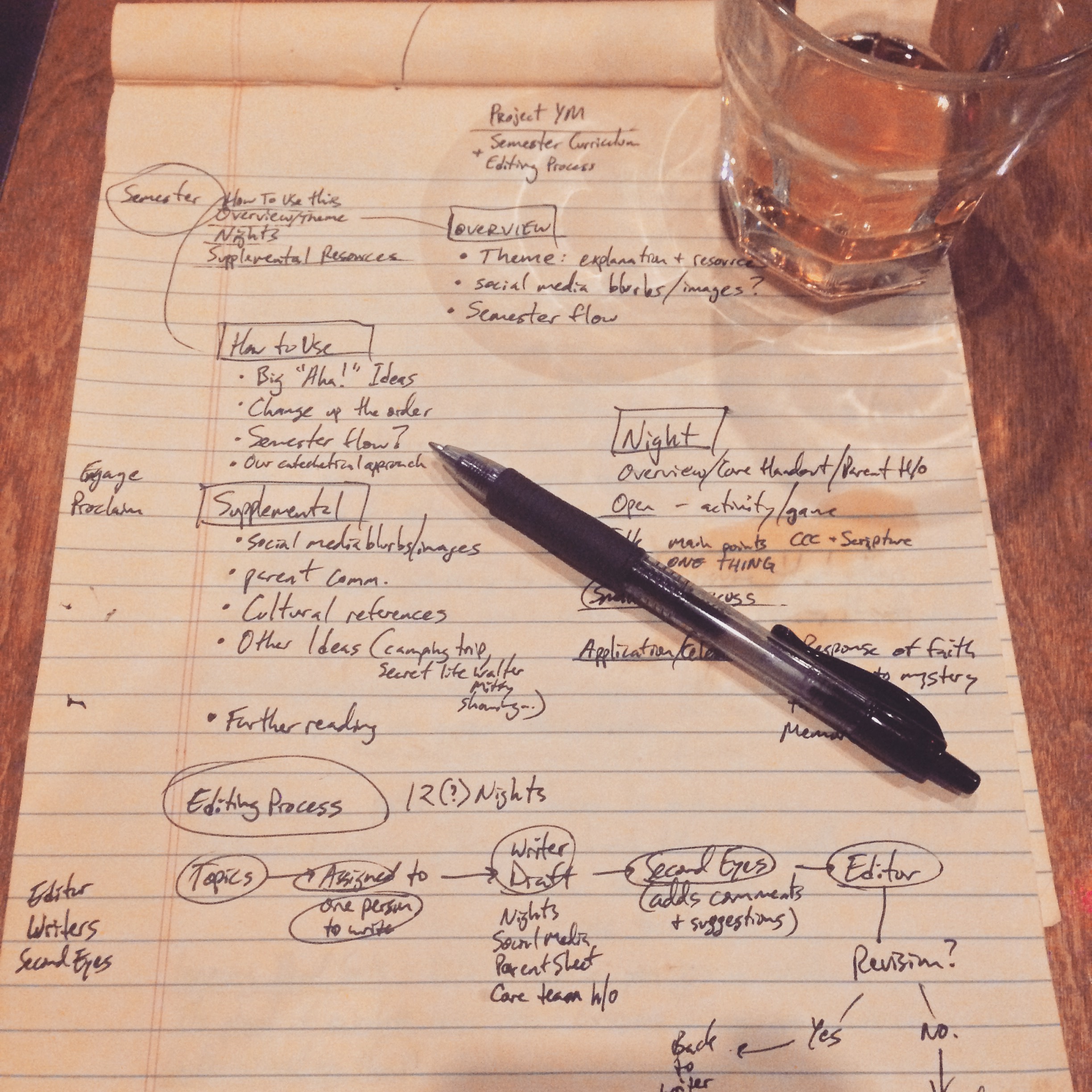 Youth ministry is a strange ministry in the Church. And most who care to have an opinion about youth ministry’s methods or importance (or Biblical deviance) have a strong one. It seems like every few months an article makes the popular rounds critiquing or praising youth ministry in general, or critiquing a perceived “common” approach to youth ministry.
Youth ministry is a strange ministry in the Church. And most who care to have an opinion about youth ministry’s methods or importance (or Biblical deviance) have a strong one. It seems like every few months an article makes the popular rounds critiquing or praising youth ministry in general, or critiquing a perceived “common” approach to youth ministry.
At best, most of these articles say very little. At worst, they show severe bias, logical fallacies, and fundamental theological mistakes. We just can’t seem to talk very constructively about youth ministry.
Here’s a few common cognitive biases, fallacies, and errors I’ve come across way too often in critiques of youth ministry of any shape and size. Think of this as vocabulary we can use to keep each other honest. This list could be a lot longer, but I’ve narrowed it down to the ones that piss me off the most.
Cognitive Biases and Logical Fallacies
The first initial problem with talking about youth ministry is the small amount of hard data and statistics we have. Which is the breeding ground for the first error:
Correlation is not Causality
New York and Chicago have reported that as ice cream sales increase, so do the number of murders. Are higher ice cream sales causing more murders? Maybe…
But most likely not. Just because one thing increases and decreases proportionally to another thing, doesn’t prove that one is causing the other to change.
This is a pretty common and tempting mistake. “People who drink red wine live longer.” Maybe… Or maybe people who can afford to drink red wine can afford better health care. “Habited religious orders are exploding with new postulants.” This might be a true statement, but it would not necessarily follow that to increase the number of new postulants in your religious order you should bring back the habit. Would it be worth testing? Yes. Is the increase proof that the habit is attracting new postulants? No.
In youth ministry critiques it sounds like “Parishes with Lifeteen are exploding.” or “Adoration causes parishes to explode.” or “All of the teens who were in a large youth ministry group left the faith in college.” More is needed, and in fact its pretty hard, to prove something is causing something else, and not just a correlation or coincidence. Which leads us to the way people tend to draw these types of conclusions in the first place…
The Plural of Anecdote is not Data
As well meaning as this article and this article is, there is a strong cognitive bias at work here as the main argument: availability bias. When we tell stories of our experience of a youth ministry “My youth ministry was all about hugs and I never learned the faith” and then turn this into a general statement “Youth ministry is about hugs and doesn’t teach people the faith.” we are in danger of building our arguments on sand.
“But, but” you might say “I know two or three other people who have had the same experience.” Ok. That may be true. But there is a strong cognitive bias at work that makes you remember the two or three stories that support your belief, and forget the rest that don’t. The availability bias is our brain’s tendency to remember things that are vivid, unusual, or emotionally charged. This bias tempts us into overestimating a situation as being representative of the way things are in general. The author of this article knows this to some extent by saying “and I’m certain readers can point to hundreds of examples of excellent youth ministry programs”, but then goes on to outline what he believes to be the “strategy for youth ministry” based on multiple personal experiences and anecdotes.
This is helped (or hurt) by the fact that the more a certain view is discussed or anecdotes of this nature are shared in public discourse, the more believable the narrative becomes. (Hence the saying "repeat something long enough and it will become true.)
Bill says, in his experience, youth ministry is just about hugs. Fred and Ted say they feel the same way, and write a blog post about it. Nancy speaks up and says in her experience, this isn’t the case. But who wants to listen to Nancy? We’re all in agreement, so Nancy must be an outlier. GET IT TOGETHER NANCY.
Historical Precedence
Ok, brace yourself. I get real testy with this one. And I know I’ll get a lot of hate mail.
I believe it is beneficial to talk about the way the early Church did ministry or Jesus did ministry. I believe in tradition and I’m not proposing we cut ties with the past. But can we all just drop the whole “I scoured the early Church Fathers and the Bible and couldn’t find any trace of youth ministry.” bit?
This type of argument is rehashed a million different ways. “Jesus didn’t need praise and worship, or guitars, or a youth group, so we shouldn’t either!”
“The early Church promised death and persecution and they had no problem attracting youth with the Gospel without a youth ministry and an instagram account. Heck they didn’t even have the internet!”
Yeah. Brilliant point. Let me ask you a small question. Do you like religious orders? What about seminaries? What about toilet paper? Jesus didn’t use toilet paper! Neither should you!
Okay, I’m going a little overboard, but the problem with an argument like this I hope should be self-evident. Sure, its a great thing to talk about. But to write an entire critique of youth ministry based on whether or not the early Church had youth ministry seems to be a stretch. Also, its a gross oversimplification of what was occuring in the early Church. To say that first century Christian communities attracted teens in Rome to the faith, and did so without youth ministry, therefore we should critically evaluate youth ministry, is reductive and an oversimplification.
You may as well say something like “If only we had Latin Mass in every parish, that would fix so many of the problems in our Church.” Or “If only we used more praise and worship, more people would come to Mass.” Both could be true, or partially true, but the reality is a lot more complicated. Which leads to…
Not Accounting for the Holy Spirit
So I’m throwing in this one more as an aside that’s really straining gnats, but I believe it is worth mentioning. When we talk about the “effectiveness” of a particular ministry or approach to ministry, we often point to the results or fruits. And Jesus told us we will know a tree by its fruit. But it is easy to forget this amazing quote from Evangelii Nuntiandi:
“Techniques of evangelization are good, but even the most advanced ones could not replace the gentle action of the Spirit. The most perfect preparation of the evangelizer has no effect without the Holy Spirit. Without the Holy Spirit the most convincing dialectic has no power over the heart of man. Without Him the most highly developed schemas resting on a sociological or psychological basis are quickly seen to be quite valueless.” EN 75
Ministry isn't a in/out function. If you do all the "right" things, you aren't owed remarkable results. A ministry that produces vocations might be a great ministry. But it might be a horrible ministry that God is still calling priests and religious from. The Holy Spirit can't be boiled down to an equation. Our conversations about youth ministry need to reflect the inability for us to really know for certain how the Holy Spirit might be moving because of, or in spite of, our ministry.
The Bias Bias
I've committed a bunch of biases and fallacies just in writing this article. But I hope we can use this short list to keep our conversations about youth ministry productive, and stray away from the lazy streams of "this caused more vocations" and "in my experience" and "well in the early church" unless it is really necessary.
Feel free to merely comment "The plural of anecdote is not data." or "Correlation is not causality." on your local youth ministry critiquing article, and let's get back to work.
Update: The Saga of Wood Laminate
Merry Christmas and Happy New Year! I haven’t written much in a few weeks, for lots of good reasons I would like to catalogue here. Prepare yourself for the mega update post.
The biggest news is that, after 6+ months of looking and looking, and looking, and commuting an hour and a half to work one way each day, and looking more…. we finally bought a house!
We're first time home owners. Buying a home is a harrowing experience. Especially when that total price of the home shows up in your bank account as a big fat red number… So I guess we grew up a little more on Dec. 4th of last year.
So we were blessed to be able to afford a modest home, within 20 minutes of work, with over half an acre lot. We’re really pumped about the lot size for a few reasons:
- We have crazy boys.
- We want to have chickens.
- My wife wants a goat. (I’m not down with this one yet…)
The small downside is that the house was built in the 60’s and has been rented out for the past 10+ years. We decided to replace carpet in the boy’s bedrooms and the office (YESSSS!!!! I GET A OFFICE!!!!!) with wood laminate.
And Thus Begins the Saga of the Wood Laminate
Act 1: The Naivete
So as the wife and I were looking at what needed to be fixed or replaced in the house and talking about wood laminate, an insidious idea crept into our heads:
Well, if we install the laminate ourselves (Me. Myself.) we could save like… $1,000 or more…
So the deal was, if I could buy a super nice dual bevel compound DeWalt mitre saw with some of the hypothetical future money we’d save, I’d do the job. We looked up some Youtube videos on installing wood laminate. Seemed easy enough. Tear up the carpet. Make sure everything’s level. Put down some padding. Install the laminate by tapping it together and interlocking it. Cut some pieces. Drink some beer. Finish in a day or two. Have friends over to marvel at your rich mahogany-looking floors and drink fine wine while listening to Christmas music and laughing.
Act 2: Preparing for Preparing
So on Dec. 4, after a hectic time closing on our house (my driver’s license was expired so we had to drive 1.5 hours back to the in-laws and look for my passport in a trailer we packed up with all our stuff 6 months ago) we closed and I got to pick up the key to our first house. It was pretty surreal.
I went to Lowes and got a load of supplies and headed to the house. Tearing up the old carpet was pretty easy. Nic helped me tear up carpet. (Nic from the increasingly popular website ngutierrez.com)
Now, the crucial step in laying wood laminate, or flooring of any type, is prepping the subfloor. That’s the stuff that is under everything. For us that means making sure the concrete slab of this house from 1960 with major foundation repairs is as level and flat as possible.
Hmm….
So I took a really really long time figuring out ways to survey the three rooms, finding low and high spots, checking the levelness of every 6 inches or so. I finally gave up on trying to get our bedrooms level. The whole house slants and slopes so that would be pretty near impossible. All the walls and doors and everything is crooked and there are very few right angles.
Ok.
So it turns out, through some internet research, that what is actually more important than levelness is flatness. Which makes sense. The thing we want to avoid is low or high spots and bumps because these will be felt as you’re walking across the floor and the laminate is buckling and bending.
So we need things to be flat.
Ok.
So after a few more trips to Lowes I buy a bag of this patching material for concrete subfloors to use in small areas where you find a low spot. I was pretty intimidated by the idea of pouring self leveling crap all over the entire room, so I thought I’d pick the easy way out with this stuff. I started with a low spot in the office. I prepped and planned for way too long and one night after work while by myself I went for it, which is where things began to get real interesting…
Act 3: The First Foibles
I’ve been staying by myself at the house working at Church in the day and going home to the house in the evenings and working on the floors. Working a lot.
The first incidence happened one of these nights. It could have been a Saturday night. Late at night. I’m by myself. I may or may not have by now responsibly consumed an adult beverage or two. I’m ready to pour some concrete.
I’m nervous. And excited. I just made the biggest most intense purchase of my life and I’m about to pour a large bucket of liquid into one of the rooms of this huge debt-building and I can practically feel the testosterone increasing my total body hair count.
I mixed up some of the patch stuff with water outside in a huge bucket.
Now the important thing to note that explains what follows is that the bag clearly states that you have like 10 minutes to use this stuff before it starts hardening. I now have a huge bucket full of cement that is starting a 10 minute clock ticking in my head.
I rush into the office and pour a tiny bit way in the back near the wall on the low spot. It doesn’t look like that much so I pour a bit more. I stare blankly at this glob of liquid I guess expecting it to do something. Then I get a trowel and start spreading it.
CRAP.
CRAAAAAAAAAP.
Its spreading a lot further then I thought I would be able to spread it. And its THICK. Panic suddenly hits me. I have a 4 inch thick glob of cement in my office that is quickly drying and when I try to spread it out….there is A LOT of it. I’m about to have a concrete bowling ball permanently attached to the back of this office floor.
I frantically get on my knees and start pulling as much of the glob back towards the rest of the room. With the trowel I’m scraping this stuff around me on both sides trying to spread as much of it out as possible.
“aaaahhhhhh……”
I’m literally groaning out loud in frustration and anxiety. I keep saying things out loud like: “$#@! #%$@! @#####$$%%$#@JFDSAF” and “WHAT WAS I THINKINGGGGGGGGG…….” and “ITS TOOOOOOO MUUUUCCCCCHHHHH…..”
I’m spreading. And spreading. My knee goes into some of the concrete mud. The first casualty. Then my shoe gets in some. Great. I’m on my knees trying to get as much of the concrete away from the back of the room as possible. Pulling it towards me and spreading it all around. Its flinging onto the walls. I don’t care if its level at this point, I just care that its not a huge dried glob of permanent cement on the floor. I get a lot of cement on my arm. I scream like a girl and run to the bathroom because I don’t want my arm to be a statue for the rest of my life. I remember I have cement on my shoe and scream again. I remove that dirty shoe and go to the bathroom. I run back into the room and continue with concrete triage.
Then I realize there is now so much concrete on the floor that I can’t reach the back of the room with my trowel anymore. And there are still big lumps.
You devil cement.
Caught in an impossible situation and feeling like I can relate to being slowly crushed by a stupid glacier or something I do some weird combonation of falling and leaning against one of the walls with my arm and reaching down with the other arm to trowel and spread.
I’m out of time. And I can’t reach this big spot right near the back wall. And I NEED to get to that spot. Its so super thick.
I still can’t reach the back of the room.
Desperate times require sacrafices. I decide to step into the concrete mud, getting me closer to the back of the room where I need to spread.
Now a quick lesson about concrete cement stuff. Essentially its very fine powdery sand suspended in liquid. Now right before I stepped in this devil liquid I thought I would gush and stick a bit. Not so. Imagine stepping onto a thin sheet of ice laying on top of a floor of ice. It felt something like that.
So my one foot goes down and I just begin slowly sliding, on one foot, towards the back of the room. Off balance and surprised by the liquid sand demon’s tormentings, I flail my arms and spaz out, which then forces my other foot to have to go down into the mud. I’m now sliding on two feet and taking a few more steps to try to slow my approach to the back of the stupid wall.
I get the back spread out thin and get to some other problem areas and then start fearing that my poor toes have seconds to live before they are forever Han Solo-ed into mishaped blocks of cement. The familiar stomach-dropping and fear coupled with anxiety and defeat washes over me. I run to the bathroom - oh crap I can’t because my feet are covered in cement mud - I crawl to the bathroom and start washing off my feet, hoping that two days from now we aren’t having a conversation with a plumber that sounds like: “Yeah your bathtub pipe is packed solid with cement. Did someone fill your bathtub with cement? It’d be pretty stupid to put lots of cement in your bathtub and down your drains…or to put cement in your bathtub at all…”
Somewhere in North Texas that night a nice woman from our bank who handled our martgage crapped her pants. She did not know why.
These were the amazing results of my FIUY project.
But wait, there’s more!
The next morning or so my wife drove down to the house, the kids were with a babysitter, and we were going to work all day on the house. We are looking at a windowsill and there is a soft spot. I poke it. Hmm… looks like termite damage. I poke around more and find a lot more soft spots. Hmm… I poke into a pretty big spot AND SEE LOTS OF LIVING TERMITES SCRAMBLE.
“F$#@!!#%^&”
I was not aware that my stomach could travel all the way down to my cemented feet.
We were destroyed. I was convinced that the entire house was filled with termites and at any moment the roof could collapse in on us and that our house just depreciated $100,000. I started wondering how long all five of us could survive on a jar of peanut butter. Maybe the crunchy kind would provide more nutritional value. Plus it would boost morale during the winter months.
My wife and I went out into the living room to wallow in self-pity for a few silent moments. I tried to flip on a light in the hallway, but it didn’t work. “Great, something else broken.” I tried another light in the house. Nothing.
Our house suddenly had no electricity. Danielle calls the electric company and they thought we wanted the electricty to start on the 11th of December, not the 4th. It was the 6th. I needed electricity to run the shop vac and other power tools. Looks like we aren’t working on the house for a few days…
Act 4: The Kübler-Ross Period
To make this long story less long, the termite damage isn’t as bad as we thought. There was a lot of cosmetic termite damage in the past, but it had been treated. We got the whole house treated and will keep an eye out. Not that big of a problem. The electricty got turned back on and it was nice to have a break away from the house and it also made us realize that this wasn’t just a weekend job, this was going to take some time and love and care.
So the following week I buy more supplies, the people at Lowes are suspicious that I’m sleeping in the kitchen department at night, and other supplies ahem (beer), and get back to work. To make a long story short, the rest of this Saga, and just moving into and fixing up the house in general, is summed up in the Kübler-Ross’ description of the stages of grief.
Lots of denial coupled with ignorance.
“It couldn’t be that hard. Just pour self levling stuff in the entire room and watch it become perfectly level!” “We can fix this!”
Anger.
“WHY IS EVERYTHING COVERED IN CAULK??????????” “MOLD IS GROWING THERE AND I FREAKING HATE NATURE.” “Termites are the spawn of Satan.” “A BLIND MAN ON FIRE COULD PLASTER BETTER THAN THIS”
Lots of bargaining.
“If we put down trim maybe we won’t notice the huge hole.” “It only caves in a little when you walk on it.” “We’ll just put a rug over that.”
Depression.
“We’ll never get this done.” “We’re going to go broke and starve and they’ll find our bodies covered in plaster and termites. I hate termites.”
And lastly, acceptance.
But we’ve finally made a lot of progress. We painted three rooms, put wood flooring and trim in two of them, unpacked the majority of our stuff, and fixed a lot of broken things.
Lots of friends came and helped at different points throughout the whole process, and we couldn’t have gotten this far without them. (Thanks Jon, Kathleen, Nic, Ryan, Cindy, Jim, Randy, Toni, James, Andy, Josh, that guy at Lowes, and everyone else!)
I even built a standing desk in the office out of some scrap wood. The office is really coming along nicely…
What this all really means
For the last 6 months, our lives have felt pretty transitory. Living with the in-laws, commuting constantly, not having all our stuff, new job, looking for a new house, and everything else that came with this huge transition.
We’re really starting to settle in. It feels great.
So…with all that being said. I’m excited to have a few small slivers of extra time to work on some projects that I’ve been neglecting. The biggest being…
REVERB CULTURE!
If this is the first time you’ve heard about Reverb Culture, get your butt over to ReverbCulture.com right now.
My commitment to Reverb Culture isn’t waning anytime soon, and even with 6 months of nothing happening on the site, there has been a small and steady stream of activity behind the scenes. People kept buying catechisms, the Facebook page hit 939 likes as of this post, I still get lots of positive emails and comments from people, and a few other behind the scenes things I can’t really mention now.
Anyways, I’m pumped to get back into the swing of things and get Reverb Culture back up and running. God hasn’t stopped tugging my heart toward it and its going to be a wild ride seeing what God does with it.
This site
I’m going to start back up my weekly Tuesday posts on all sorts of random strange topics. I haven’t yet been able to nail down a specific topic or niche or even a set of topics for this site, but I think that’s just fine. The catechism, coffee, and hipsters. And some occasional youth ministry posts.
In Conclusion
If you read this far, I caught my hair on fire once when I was a kid (accident). Stay tuned for more excitement. Whew.
That’ll do pig. That’ll do.
Blue Jeans and the Catechism
I wrote something and Word on Fire thought it was good enough to publish! Read the Catechism! Just wanted to share it with y'all here. You can read the full article here. Do me a favor and leave a comment on the article on Word on Fire. :)
There was one thing on the minds of all Bishops gathered in Rome on November 25, 1985: blue jeans.
George Cardinal Law addressed the Bishops with these words: “Iuvenes Bostoniensis, Leningradiensis et Sacti Jacobi in Chile induti sunt ‘Blue Jeans’ et audiunt et saltant eandem musicam.”
And for the first time in the history of Catholic Synods, Bishops were talking about blue jeans. In Latin.
This is the opening of the 1985 Extraordinary Synod of Bishops, twenty years after the close of Vatican II. Cardinal Law spoke to all the bishops tasked with reviewing Vatican II’s twenty year impact on the Church. His argument was simple but clear.
Cardinal Schonborn, a major editor of the Catechism who was present at this Synod, summarizes Cardinal Law’s speech in Introduction to the Catechism of the Catholic Church:
“In a world where young people all over the world wear the same blue jeans, shouldn’t it be possible to express the faith in a common language? It is not only possible, it is necessary – and mainly for two reasons: first, because the world has definitively become one, sharing the same problems, the same anxieties and hopes; and second, because the faith in itself is unity.
Unity is an essential feature of Christian faith. This vision of one faith in one world fired not only Cardinal Law’s inspiration; it became the driving force of the synod’s discussion about the idea of a catechism. At the end of the synod, the Holy Father made the idea his own.” (p.39)
At the close of this Synod Pope St. John Paul II put together a commission of Bishops and Cardinals, assisted by then Cardinal Ratzinger, to take up Cardinal Law’s idea and write a universal Catechism of the Catholic Church. It would be the first of its kind since Catechism of Trent written in 1566, over 400 years prior.
The call for a Catechism might sound antiquated. It might sound this way most especially for people passionate about the New Evangelization. The New Evangelization is a call for evangelistic efforts new in “ardor, methods, and expressions” that engage modern culture and modern man.
How could a Catechism possibly engage our culture and the people we find ourselves tasked with evangelizing? How could this be an authentic fruit of Vatican II? Is this a return to the painful Catechisms of the past forcibly shoved into the minds of so many Americans?....
Merry Thanks-Giving from Your Over-Caffeinated-Catechist
http://youtu.be/TQnXuc-TbeU
"What have you that you did not receive?" 1 Corinthians 4:7
Thanksgiving is just around the corner. Firstly thank you, dear reader, for reading and hanging out here with me on this thing. Its been fun, and I think if you and me stick together, we'll really go somewhere. So in honor of this glorious holiday that is frequently under appreciated and ruined by preemptive commercial Christmas decorations, I thought I should take a minute to send you a personal and intimate video exhorting you to think about the issues this Thanksgiving.
For all Thanksgiving-relevant Catechism passages check out this link.
Eat some turkey for me.
You're welcome.
Hippest Stuff Roundup
Trying something a little different, this week's post is a roundup of a bunch of super hip awesome stuff I've found around the world wide wild web in the past couple weeks. Broad range of things made this list, and I think you should know about them.
Grid-it
This is the coolest freaking thing ever. You have all those loose bits of wire and pens and usb drives and paintbrushes and batarangs in your work bag or laptop bag or whatever. The Grid-it helps you organize all that onto one pad of grippies and helps your OCD tendencies. I would love to have one for my work bag. My advice is to send this link to someone who will buy you a Christmas present.
You can buy them at Cocoon Innovations. (This is not an affiliate link. I'm not getting paid to say this is awesome. But it is.)
Rome From Above
Spirit Juice Studios. If you don't know about them, you should. They flew a quad-copter above Rome and got some epic shots. Such cool. Such hipster.
http://vimeo.com/110809710
Drunk Ex-Pastors
Hat-tip to good friend Sean for sending this podcast my way. Its not as bad as it sounds, but bad enough to be amazing. Two ex-protestant pastors (one now agnostic, one now a Catholic) drink modestly and talk about a broad range of topics. You might recognize the Catholic as Jason Stellman from the blog Creed Code Cult.
I really enjoy this podcast because they are smart and the conversations between a Catholic convert and an agnostic are super interesting. They both know Scripture super well, and the fundamentalist jokes abound. I really enjoy Jason's anecdotes about the life of a used-car salesman. If you share an episode on social media, they'll drink a shot in your honor and give you a shoutout at the beginning of the next episode!
I recommend starting with episode 11. It has a lot of the back story behind the podcast and Jason Stellman's super interesting story about leaving his protestant roots and damning himself to hell.
Listen to Drunk Ex-Pastors. You can find it on iTunes or on your podcast app.
The Frank Show
Speaking of podcasts, my fellow coworkers/friends started a podcast for our parish called The Frank Show. (Frank as in open and honest. Also as in short for Francis...'cause we're St. Francis of Assisi Parish...yeah...). For the first bunch of episodes we are reading through Sherry Weddell's book "Forming Intentional Disciples: The Path to Knowing and Following Jesus".
Each week myself, Jared Zimmerer, and Nic Gutierrez will read a chapter and discuss. Where we will go from there? Who knows. But it will be frankly, captivating.
Buy the book or steal it from a friend and read along with us! We are currently only on Soundcloud, but we'll be getting the podcast up on iTunes soon. Let us know what you think!
https://soundcloud.com/sfafrankshow
T-shirt Mock Up
This is a quick little design I'm thinking about making a t-shirt. What do you think? Do you want a t-shirt like this? It seems like parishes everywhere are struggling to find enough catechist volunteers for the number of kids they have. Being a catechist is an important calling in the Church. Hopefully this t-shirt will wake some people up!
It probably wouldn't have the Reverb Culture logo on it. It would also be a t-shirt.
Let me know if you'd buy one. If enough people respond, I'll make them!
Save a Soul. Be a Catechist.
Great band named Joseph
Hat tip to good friend Jon. I'm really diggin' this female trio with lots of harmony and folk. Sweet band website too. If you're looking for them on Spotify, type "Joseph" and then one of their song titles like "Lifted Away" (one of my fav's).
Dribbble
Hat tip to Inspired Angela for showing me Dribbble. In a recent Coffee Interview I picked Angela's brain about design and inspiration. Dribbble is a place where graphics designers showcase their work. You can search things like "newsletter" or "logo" or "christmas" and get some inspiration for the project you're working on. All art is stolen. Recently I had to design a 5 foot banner with all Christmas/Advent schedule of all events going on at our Church. Dribbble gave me some color palette ideas and helped get me past the blank page of death.
Jim Lepage's Designs
Speaking of graphic design, I found this guy Jim somehow and he has an amazing collection of designs made for every book of the Bible. I really dig his style. Some of the designs are scandalous, so you've been warned. He's real good.
Sophia Sketchpad
These are some cool videos to help with catechesis. I really love those drawing-while-explaining videos, and these will be a bunch that cover the faith. They are just starting out, so send them some love and some money. It looks like they are gearing this towards classroom use, and they have some supplemental teacher resources to go with the videos.
Firepole Fail
And last but certainly the most important: this video sent to me by my good friend Chris.
There is so much in this. So many life lessons. Such depth. Such metaphor. Life.
Did you like this post? Is there anything you would add?
If you liked this post, you might enjoy Tools, Tech, and Gear for Parish Design and More Tech for Parish Ministry
An Evangelistic Model for Youth Ministry
There are a few problems I’ve come across frequently in conversations about youth ministry. The first is sweeping generalizations. “Large group models suck.” Or “Life Teen is inadequate.” Or “We need more cowbell.” Most critiques of any type of youth ministry model I’ve read create a straw man based on personal experiences of deficient youth ministry. A good model or strategy can always be poorly executed. Another problem is a misunderstanding of the purpose of different types of events or programs a youth ministry may do. To me, looking at the large group event and crying “This doesn’t go deep enough or make disciples!” is like expecting an Alpha course to prepare people for Baptism. That's not the purpose of Alpha. There are multiple contact points with youth that should constantly be pointing to a next step in the Christian life.
What I don't see much of is anyone formally proposing a model of youth ministry that extends beyond a specific weekly event. I wanted to propose a paradigm loosely based on the Catechumenate that I currently believe is the best way to approach youth ministry.
The Mission Territory
Youth ministry reaches out to a specific mission territory in a specific time and place and culture. Pope St. John Paul II in Redemptoris Missio defined three mission situations of evangelization that exist today.
First is the situation in which people haven’t heard and therefore don’t care about Jesus Christ and the Gospel. This is the area of ad gentes missionary activity.
The second is the situation in which people have heard and do care about Jesus and his Gospel. This is the area of pastoral activity.
The third, and most culturally common, is the situation in which people have heard or think they’ve heard about Jesus and everything He has to offer, and have decided to reject it. This is apparent in America even on the scale of whole families, generations, or communities. They’ve been exposed to the Church in some degree, and have rejected it. This is where the need for the “new” evangelization comes from. It is a new territory to be evangelizing people who have already been exposed to the Gospel message and are not hearing it for the first time.
I think this third situation is the most commonly experienced in youth ministries around the country. But to some degree all three situations are present and should be dealt with if youth ministry is going to make disciples.
Acts 2
The Catechumenate is an ancient model of Christian Initiation that has been used in some form since the Early Church. It is a process that leads a person on the fringes of the Church into full sacramental communion with Jesus Christ within the Church. In our post-Christian cultural context of Catholics who are sacramentalized but not evangelized, I think the Catechumenate is still a powerful organizing model for evangelization, because of its focus on conversion and movement.
The Catechumenate exists in a seminal form as early as Acts 2. Go read Acts 2. Do it.
The Apostles "going out" into Jerusalem after Pentecost caused non-Christians to take notice. They were amazed and perplexed and asked "What does this mean?" St. Peter stands up and gives the first sermon of the post-Pentecost Catholic Church and proclaims the kerygma, or the proclamation of Jesus Christ and the Gospel. The crowd is "cut to the heart" and asks "What shall we do?" This is a moment of conversion and they crave to respond to what they've heard. "Repent, and be baptized every one of you in the name of Jesus Christ for the forgiveness of your sins and you will receive the gift of the Holy Spirit."
So the three thousand in the crowd do as Peter recommends and they enter the Church, the first RCIA class of 33 A.D. But what do you do with three thousand newly baptized Christians? Form Church communities where the Christians can live out discipleship! What does that look like?
"And they devoted themselves to the apostle's teaching and the communal like, to the breaking of bread and to prayer." Acts 2:42
I'll save my rant about the Catechism (creed, sacraments, morality, and prayer) and its importance in the whole discipleship conversation for later.
A Process of Evangelization
The early Church's evangelization efforts, and the Catechumenate, take on this loose rhythm:
I think this is the best way to organize a youth ministry because it focuses on outreach, conversion, movement, and discipleship. Its christocentric. It is balanced. Focus too much on one area and you'll have unhealthy results. If we aren't focused on conversion, then we are just running a club. If we aren't intentionally focused on moving teens from where they towards a deeper relationship with Christ, then they are moving backwards. If we aren't focused on discipleship and only focused on initial proclamation, then we are providing a superficial spiritual high.
It also takes into consideration and addresses the various levels of commitment to Christ a large group of teens will have.
Fringe
"They were perplexed and amazed and asked "What does this mean?" but others mocking said "They are filled with new wine." Acts 2:12
You'll notice that there were two reactions to the Apostles. One was open and curious and one was hostile. Just like JPII's three situations of evangelization, there are two forms of fringe youth: those who have never really heard the Gospel, and those who are openly rejecting it. The first step in youth ministry is engaging and building trust with youth on the fringes of the Church.
Examples: meeting teens at school, going to sports games, fun social activities, outreach outside the parish, softball tournaments
Proclamation (kerygma)
"Men of Israel, hear these words: Jesus of Nazareth..." Acts 2:14-36 "Now when they heard this they were cut to the heart...'What shall we do?'"Acts 2:37
St. Peter proclaimed, in a powerful and definitive way, the Person of Jesus Christ and the Gospel message. He appealed to the life, death, and resurrection of Jesus, the prophecies that foretold his coming, and the witness of the Apostles. It was intentional and direct and it cut them to the heart. It demanded a response. Youth ministry needs to create moments where the basic Gospel message can be proclaimed to youth in a way that demands a response from them.
Examples: large group model, Lifeteen model, Steubenville Conferences, Covecrest, Summer camps, Confirmation retreats
Conversion (metanoia)
"Repent and be baptized every one of you in the name of Jesus Christ for the forgiveness of your sins; and you shall receive the same Holy Spirit." Acts 2:38-40
The climactic transitional moment for the hearers marks a turning point where they no longer are passive or on the outside. They make a public and definite decision to repent of sin and "turn" their lives fully over to Jesus, beginning discipleship. They encounter the Person of Jesus Christ in the sacraments and become initiated into the Church
Examples: Connecting youth to the sacraments, Mass, encouraging repentance of sin, renewal of baptismal promises, adoration, Confession
Discipleship (didache)
"And they devoted themselves to the Apostles' teaching and the communal life, to the breaking of bread and to the prayers." Acts 2:42
Only AFTER conversion can the newly initiated begin diving deep into the demands of discipleship. This is the place for proper catechesis and for a challenging of youth to dive deep into the life of a disciple. This stage requires more individual attention and accountability, and small groups seem best suited for this period of growth.
Examples: small group model, yDisciple, Bible study, discipleship, Forming Intentional Disciples, deeper formation and catechesis
Mission (apostolos)
"Go therefore and make disciples of all nations..." Matthew 28:19
The final stage of discipleship is being sent by Christ with the mission of the Church to go make disciples. You'll know your ministry is thriving and youth are maturing when they begin using their charisms and gifts to go out and make disciples of others.
Examples: youth taking on ministry, youth helping lead small groups, giving their witness, putting on retreats, giving talks, leading others in discipleship
So...
This is just a quick glance at the way I've grown to think about youth ministry. None of this is mine, its all stolen from a hundred different places. There is so much more that I could have said and have left out, but I think this gives a good starting point. The big takeaway is that there are so many ways this can be accomplished. But I do stand by the argument that this is one of the most effective ways to approach and think about structuring a youth ministry at a parish.
What do you think?
I Don't Like Youth "Ministry"
I don't like youth ministry. Maybe its due to my non-conformist tendencies (a weakness). Maybe I'm playing a semantics game. Or maybe I'm crafting a straw man. But I don't have much written for this Tuesday, so allow me to just rant and externally process.
I think inherent in the culture of youth ministry over the past decade or two is a noble sense that our kids are lost and the Church needs to work harder to save them. Some very effective and dynamic approaches have developed and I believe they have done a lot of good.
But now a generation of home-grown youth from Lifeteen-esque programs are going to college and growing up. As youth ministers and lay evangelists in the Church, we are all struggling with this sneaking suspicion that our youth aren't staying Catholic. I don't know the statistics. I'm not critiquing Lifeteen or any method or approach per se.
But I think if I were honest with myself (a youth minister) and everyone else, I would say that I don't really like youth ministry. I don't think it should exist. At least not as a "ministry".
When most Catholics use the word "ministry" they mean a service of help provided by the Church to a particular group of people. Divorced ministry. Homeless ministry. Campus ministry. Young Adult ministry. Youth ministry. Pastoral ministry.
I've been starting to feel that our Churches don't need that much youth ministry. If youth ministry is a means by which the Church tries to evangelize and serve her youth, then it makes sense to have a youth ministry. But what happens once a teen is evangelized? Where does a teen go? Back to the youth ministry?
I don't think Churches need youth ministry. I think our Church needs youth. And therefore we don't need a youth ministry as an end to itself, we need a youthful Church.
The youth have a Church. Its their parent's Church. And its their grandparent's Church. And its your Church. Youth Ministry is what reaches outside the Church to youth, but it should be more like a bus station than a home.
Three years ago I started calling our youth ministry in Toledo the "St. Patricks Young Church Movement". Or just "St. Pat's Young Church". I moved to Texas where the youth ministry took on the same name. St. Francis Young Church. Youth Minister friends started calling asking if they could use the name too. Our goal is to lead teens closer to Christ and his Church through community, worship, and discipleship. It's all based on Acts 2. Preach the Gospel, ask youth to repent and join Jesus and His Church, and then BE Church - community (the Christian life), worship (the sacraments) and discipleship (the creed and prayer of a Christian). When youth show up to our "events" I want them to fall in love with a different way of life offered by the Church, not a ministry.
It might seem trite and like straining gnats, but for me it represented a shift in my focus, purpose, and "ministry".
The goal of "youth ministry" is not to get kids to be involved in youth ministry. The goal of youth ministry is to get kids to fall in love with Christ and become part of His Church.
No one wants to live in a hospital. No one wants to just perpetually fix themselves.
To me it seemed like I was inviting kids to come get fixed, and become a part of a group of people who are all about fixing people.
"Hey, you! You should come to my "fixing kids" night. It's every Sunday night. It's a group and community all focused on fixing kids and bringing them to Christ. Once you've found Jesus, you can then keep coming back to a group trying to get kids to find Jesus."
I started feeling like the end goal of everything was ministering to youth. But perpetually ministering is not the goal. The goal is connecting young people to the Church, not to a ministry of the Church. The goal is for the young people of our Church to BE Church.
Maybe this is why we are all struggling with the kid who graduated from high school three years ago and still only feels fed and close to God in the youth ministry. They are the lifelong core members.
The first converts to Catholicism in Acts 2 devoted themselves to the teaching of the Apostles, the breaking of bread, the community of disciples, and prayer. Is our ministry reaching out and helping youth devote themselves to our Church's life of creed, sacraments, morality, and prayer? The early Church evangelized very powerfully through their daily witness of living as Church.
Should't every Church have a ministry that is focused first on "ministering" and then on mobilizing the young people to be part of their Church? Shouldn't I as a youth minister be a little more concerned with carving out a place for youth to BE Church at our Parish? A Church does youth ministry when a kid goes to Mass. A Church does youth ministry when a kid goes to Confession. A Church does youth ministry when a kid serves as a Eucharistic minister, or altar server, or in the food pantry, or as a Lector.
Youth ministry in its current form is a bandaid because parents don't know how to evangelize their kids. Most parents don't know the faith. Most parents don't know Jesus. But parents are the primary catechists and the first heralds of the Gospel in a child's life. The more we help youth be the young Church, the more our Church will evangelize without the help of our youth "ministry". And the more our youth will grow up and do the same to their kids - connect them to Jesus and His Church.
The more we make youth "ministry" obsolete and unnecessary the more we do our job as youth ministers. The more we empower people to be Church, the more families will evangelize their kids, and the more kids will become part of the Church, and not ministry.
The Marriage of the Head and the Heart
We sat every Sunday morning in that hot master-bedroom-turned-classroom of an old cinderblock house on Church property. It seemed to flow in and out of the dead leaves and sticks and palmettos and low hanging spanish moss like a stereotypical Florida home built in the 70’s. Brown and tan and empty and rotting and weirdly nostalgic and safe. Like visiting your friend’s granny. Regardless, we definitely dragged our feet in the rocks after Mass as we walked from the Church to the house where CCD took place. The room always smelled like granny was hiding in a closet sniffing pinesol. All the metal chairs in the hot but otherwise empty room faced the front and therefore so did all 18 of us sweaty 9th graders. This is catechesis in 2003 in Valrico, Florida. It was my freshman year of high school. If you’re reading this, chances are you too can harken back to that classroom where you stared at the back of Melissa’s head wondering what a Mexican wedding would look like. You might still remember the strange endearing sympathy you felt as your volunteer catechists stood at a half-broken formica table and tried to hold the attention of a room full of your hormonal freshman peers raised on Pokemon, Adult Swim, and iPods.
Let’s be honest: those Sadlier religious-ed books were out-gunned from the beginning.
To this day I still wonder how I ended up willing to (or at least praying that I would be willing to) die for the things those volunteers spoke about in that room. I remember telling my friend Darryl to say “transubstantiation” to throw the teacher off. The Catholic faith was another chunk of information I could wield to stroke my ego just like the (little) philosophy, martial arts, and LOTR information I possessed.
Somewhere during senior year of high school or freshman year of college I bumped directly into Jesus for the first time, andthen quickly tried to ignore Him by burying myself in self-aggrandizing information gluttony. Its a lot more comfortable to follow Jesus if you feel like you’re an expert in Jesus-knowledge. I learned about typology and colored salvation history timelines. I could recite - from memory - Jeff Cavin’s hour long talk from the audio CD “I’m Not Being Fed”. But I made sure to never look up from the information directly into the eyes of Christ. It was like a relationship that only existed on Facebook.
I find it sad that to this day too many people believe there is a strong dichotomy between Catholic doctrine and a transformational relationship with a personal God. I’ve been guilty of this most of my life. Many times I’ve been running from one extreme to the other. I’ve either hidden in my head from my heart’s need for Jesus, or headlessly chased Jesus around with my heart.
“The principal task entrusted to the Council by Pope John XXIII was to guard and present better the precious deposit of Christian doctrine in order to make it more accessible to the Christian faithful and to all people of good will.”
Do you know what Pope St. John XXIII believed the principle task of Vatican II was? What he really wanted to accomplish with all that Church window opening? “To guard and present better the precious deposit of faith”. Catholics who are deep in the evangelization frenzy, steeped in Catholic meditations on beauty, or armed to the teeth with apologetics tracts might hear this as a sad trombone.
And maybe that’s because deep down we aren’t sure if there can exist a marriage between our heads and our hearts.
Maybe we really believe that when we are 19 and reckless we can have a religion like a love-affair but when we are finally 35 and mortgaged we need to grow up and learn some facts and let the naive passion of our youth fade into the past like First Communion.
I, however, choose to believe that the panting of our hearts can be quickened by the slow and seductive revelation of God in the form of doctrine, tradition, and dogma. Maybe that’s really what all the doctrine should be viewed as: a lover writing from a foreign land revealing who He is.
For too long the distance between the head and the heart has forced me into a false dichotomy. I should either be a frenetic charismatic or a staunch Thomist. The spirit and the letter. I think its normal for this tension to exist. Its part of how we are made. But what would it look like if the two were married?
It looks like Divine Revelation.
I believe it looks like the Catechism of the Catholic Church.
Fr. Raniero Cantalamessa, preacher to the Papal Household, seems to agree.
“…we need to discover the CCC’s pulsating heart. And what is this heart? It is not a dogma or a truth, a doctrine or an ethical principle. It is a Person: Jesus Christ! “On page after page,” – the Holy Father writes regarding the CCC in the same Apostolic Letter – “we find that what is presented here is no theory, but an encounter with a Person who lives within the Church”
We can get our heart into the heart of Christ by walking over the bridge of revelation.
The more Revelation becomes our bridge to the heart of God, the more we unite our head and our hearts. Then we can begin to transform the catechism from “a silent instrument, like a valuable violin resting on a velvet cloth, into an instrument that sounds and rouses hearts.”
[photo: rocket-fueled]






